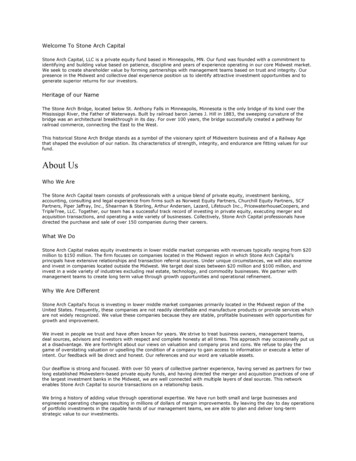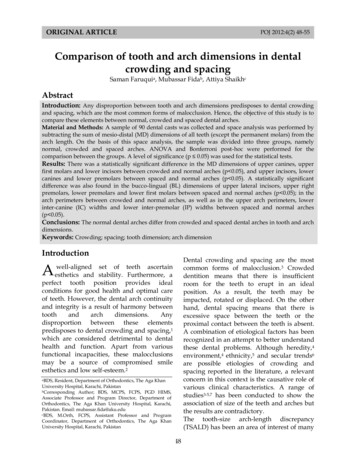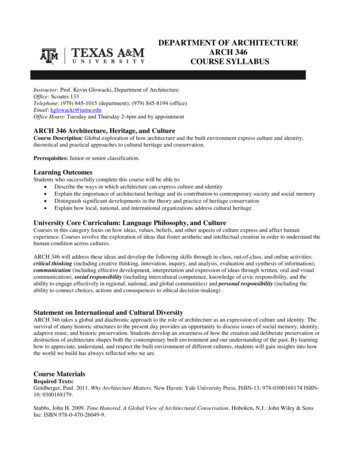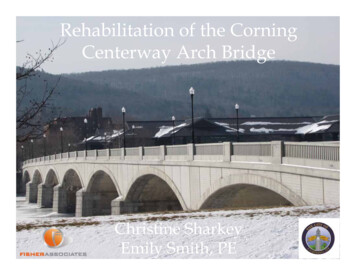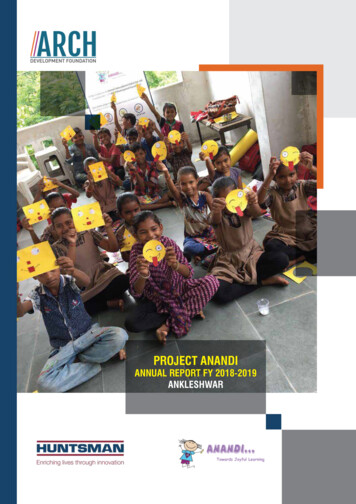
Transcription
PROJECT ANANDIANNUAL REPORT FY 2018-2019ANKLESHWAR
Education is no longer just about learning tangible and measurable skills. Our educationalparadigms in Government schools relies on the “average” measurements and standardization.Children are prepared to memorize information and then take examinations. Not only is thisapproach not successful for children, it may also not be psychologically healthy for somestudents.Although children should be prepped in core subjects such as mathematics and language, orscience through class room teaching in past few years, it is now also important to shift focusmore on teaching how to learn. Holistic education redefines not only what a core subject is, italso redefines how children should be taught.
NOTE FROM HUNTSMANHuntsman International has fornearly fifty years has been usingscience and ingenuity to createinnovations that play a criticalpart in everyday lives of millionsof people, as the mantra is“Enrichinglivesthroughinnovation.”CSR forms the core value atHuntsman as it is believed thatwhat the company takes fromthe community, it must rightfullyreturn it back to them. CSRactivities take place in variousforms and shapes.Huntsman strongly believes thatno contribution is as big asbuilding the capacity of todaysand the next generationindividuals and there can be nobetter way than investing ineducation in order to prepare thestalwarts of a future ion in GovernmentPrimary School aims at holisticdevelopment of children at large.The array of various activitiesthrough activity based learningis the key strength of the project.Huntsman is always keen onsustainable initiatives and thisproject is a unique example ofthe same.Developing key strategic focusareas, effective implementationand a long term collaboration forsustainable change can ensurethat as a whole the communitycan develop and strategicalliance can be developed tomeet the future requirements.Throughsuchinitiatives,Huntsman aims to intervenetowardstheholisticdevelopment of the children,majority of who study in theGovernment schools of thenation in order to make themcapable, efficient and above allensure that they are not leftbehind from the overall purviewof development.More focussed, result basedinterventions can surely ensurethat each child is in school andlearning well and above allenjoys the process of learning!This is just the beginning .
NOTE FROM ARCH FOUNDATION“ARCH- a supporting structure that lifts not only itself, but other structures too”Arch Foundation works on a basic premise that if onecan do it well, two can do it better. Collaboration hasbeen a key focus area for work at ARCH Foundationand identification of collaborations for sustainable,holistic development has been the forefront of allwork undertaken at the Foundation.Project Anandi was conceived by many stalwarts in,around and of the community as a result of whichmany tangible as well as intangible results wereachieved. The project focused on the development ofchildren, academically, socially, morally and above allcreatively. In this process, the development wasevident in not only the children but also thecommunity at large. Hand-holding has been a veryimportant component of growth and development atARCH Foundation.At ARCH we move forward with a belief that eachindividual has an inherent capacity to contributetowards developing oneself and the surroundingcommunity, what they lack is guidance andresources.Through using the trickle up, bottom downapproaches of communication and networking,ARCH tries to develop projects for interventions thatnot only develop one aspect of core interest, but inthe process actively and passively develops the otheraspects of community organisation and developmenttoo.Project Anandi has been a joint, collaborative effort ofall the stakeholders involved in the project whichreaped desired results.Education is of foremost importance when it comesto communitydevelopmentTogetherwe can, togetherwe will, toandmakeProjectit a achievingunderstand that each child is unique and identificationnotuniquenessonly the learningthe studentsbut inoftheof thatis the levelskey to ofprepareindividualsprocessthataimedcreating activea communitythat isallselftomorroware atcreative,and abovesustainable, independent and above all aware of whatfocussed.the future course of action should be to develop theircommunity at large.
INTRODUCTIONIt is said “if the child does not learn in a way you teach, you must teachin a way the child can learn.” Each child is different with innatecapacities to learn and grow. How you foster that growth is of utmostimportance. No one common method can help the children learn andgrow. You need to keep identifying how to keep the children engagedeach day, every day. In this fast changing contemporary world, thelearning needs of the children too keep changing. It is very importantfor the educators and instructors to keep abreast with the needs of thechildren in order to identify and support the growth and developmentalneeds of the children and prepare them for a bright future ahead.Accepting the belief that each child is different would require a set ofunique teaching and learning methodologies to help the child reachhis/her fullest potential.With this philosophy of identifying the uniqueness in each child andfostering creativity and development, Project Anandi was conceivedkeeping in mind the differential learning needs of the children.ANNUAL REPORT FY 2018-2019PROJECT GOALThe broad goal of Project Anandiis to create an ecosystemwhich promotes holisticdevelopment of the children.
1STRATEGIC FOCUS AREASAcademic Intervention:The Sustainable Development Goal number 4 talks ofQuality Education. Development of the basic Three“R’s” (Reading, wRiting and aRithmetic) in educationis quite essential. Many Civil Society Organisationshave intervened in recreational activities of thechildren at school. But Project Anandi hasstrategically focussed on the academic interventionalong with creative development of the children. Thiswill not only improve the academic levels of thechildren but also help in bringing out the creative sideof the children as well.3Resource Management:It has been found in many schools that there aremany resources available in the school. What isrequired in an eye to identify what can be of use andwhat not. The Project focuses on optimum utilisationof the human as well as non- human resourcesavailable to the children for learning. It is seen inmany schools that donations, most often received inmaterial are often unused and most of the time thoseresources lie untouched. It is through this project thatsuch resources are brought to the knowledge of theadministration and the teachers so that they can beoptimally utilised and the overall process of teachingand learning can benefit.52Creative Activities:The creative activities under project Anandi focus onhelping the children identify that there are a hundredways of doing one thing and each time in doing so, amarvel is created. Project Anandi focuses onstrategic creative activities that not only help childrenenjoy but in the process also develops the muchneeded soft skills in the children.4Health and Hygiene:Health and hygiene form a very important componentof a child’s healthy growth and development. It is inthe growing years that children learn to identify goodand bad habits which make them behave in certainmanners in the near future. Since children spend aconsiderable amount of time in school wherecontacts with their natural and immediateenvironment as well as other children is inevitable, itis very necessary to develop healthy sanitationpractices so that the children stay away from certaindiseases.The Health and Hygiene component of Project Anandiaims to improve health and learning performance ofschool going children by extending this to theirfamilies thereby reducing the incidence of diseasesthat spread through the lack of proper sanitation andhygiene practices.Capacity Building:Often play is seen as a relief from serious learning but for children, play itself is serious learning. It is verynecessary to identify the innate capacities of teachers and children both to enhance the overall teaching andlearning experiences. The traditional teaching and learning methodologies seldom create interest in the mindsof the children. It is very necessary to keep updating oneself with what the children like and experiment thesame in bringing about changes in the way content is delivered which not only ensure enjoyment in the processbut also make sure that retention is made easier. Project Anandi ensures that children are indulged in play whilethe capacities of the teachers are built to deliver what is best for the child.5ANNUAL REPORT FY 2018-2019
SCHOOL PROFILEFor the implementation of Project Anandi,two Government Municipal schools from twovillages viz. Sanjali and Bakrol fromAnkleshwar Taluka were selected.Ankleshwar has one of the largest industrialbelts in the State known as AnkleshwarIndustrial Association (AIA) which is thelargest organisation in GIDC where over twothousand industries are located.Mostly known for production of chemicals,pesticides, pharmaceuticals, paints andchemicals, it usually attracts a lot of peoplefrom neighbouring states for the purpose oflabour.This is one reason why this Taluka has a lotof migrants coming in for labour work fromthe states of UP and Bihar.While the Government school in Bakrol hasgujarati population, the selected school inSanjali has about thirty five to forty percentchildren who come from migrated families.These children are the ones who gotadmission through lateral entry in fifth andsixth standard. This makes it all the moredifficult for these children to cope up as theteaching and learning process is largelyvernacular in nature. Intervention in thisschool was all the more necessary tounderstand how to improve the lop-sidedmilestones of learning prevalent in thesemigrant children.TOTAL OUTREACHFocus on maximum number of children covered as beneficiaries has been ensured and as a result.SANJALIBAKROLBoysBoysGirls49%ANNUAL REPORT FY 2018-201951%51%Girls49%
SALIENT FEATURES OF THE PROGRAMChild Centric1 Child Centric:Children learn in a way thatinvolves not only their minds buttheir physical self also. Somephysical activity ensures activeparticipation of the mind too.Thus, all the activities underProject Anandi are designedkeeping in mind the interestareas of the children andproviding them an enablingenvironment to learn and growwhere they are actively involvedin the process of learning.Activity BasedLearningJoyful Atmosphere2 Activity Based Learning:In the growing years of life, children are often hyperactive andmonotonous ways of doing one thing often makes them loseinterest in what they do which ultimately results in loss ofattention.It is very important to keep the children engaged so that attentioncan be demanded. For this, Project Anandi focuses a lot on activitybased learning which keeps the children engaged all the time inlearning and creating new things. Even the curriculum is taught inan activity based manner which makes the subject matter not onlyinteresting but ensures retention too.3 Joyful Atmosphere:Children should be provided witha happy and a healthyenvironment to learn and growwhich not only helps build theirintelligent quotient but alsoprepares them to build a strongeremotionalquotient.Thephilosophy of “a happy child isa healthy child”, is thusfollowed in the project activitiesto make learning interesting andfun.7
SPADE WORKOrientation of CSR team and Local Management from Huntsman- Ankleshwar .9Orientation meeting with Principal and Sarpanch .9Obtaining permission from Education department .10Summer Camp activities – Creative and Science based – entry level activities .11Visualization workshop with School authorities and students .12Formation of project management committee .13Baseline study .13Program launching at both the schools .19ANNUAL REPORT FY 2018-2019
SPADE WORKOrientation of CsrTeam & Local Managementfrom Huntsman- AnkleshwarA lot of contemplating, debating, thinking andanalyzing went into the process of conceivingProject Anandi.A detailed presentation on program designincluding its broad methodology, activitiesinvolved was made in from of the Huntsman,Ankleshwar CSR team.Huntsman wanted to engage in an activity thatdoes not only touches the issue, but activities thatare sustained for a long time that would produceviable results in the end.Huntsman being the primary stakeholder, theywanted to work on the academic front thataltogether builds efficient next generationworkforce and thus the idea of implementingProject Anandi was planted.Huntsman Corporation assured to provide fullsupport towards the implementation of the projectin order to yield necessary outcome.Orientation Meeting withPrincipal and SarpanchOnce the project got a heads up by Huntsman, itwas necessary to take the school administrationof both the schools in confidence regarding theproject and its possible outcome. A meeting fordiscussing the key areas of the project and itseffective implementation was held with the keystakeholders viz the Principal, Teachers and thekey leaders of both the villages was held.Since it is a community based activity where notonly the children are benefitting but the entirecommunity as a whole, it was very important toengage the members as well. The detailedproject outline and its expected outcomes inorder to transform and gain insightfulsuggestions for effective implementation wereshared with the stakeholders.The overall idea was to engage the communitymembers into the entire effort to bring about adevelopment in not only the academic front ofthe children but also ensure that in the processthe community leadership and participation alsodevelops.9
Obtaining Permission from Education DepartmentKeeping the major stakeholders viz. the Education Department in the main purview of theproject, permission to intervene in the already existing school curriculum was sought so that theimplementation is uninterrupted and in line with the broad objectives of the educationdepartment.This also helped in ensuring credibility of the program implemented and sought participation ofthe school administration with ease.ANNUAL REPORT FY 2018-201912
Summer Camp ActivitiesCreative and Science Based – Entry Level ActivitiesBuilding a rapport with the main beneficiaries thatis the children was of utmost importance togenerate interest in the activities and above allbuild trust in the minds of the children regardingthe entire program.Children participate only when they realize thatthere is ample amount of fun in the work they aregoing to engage into, not knowing that in the longrun, these activities can lead to their developmentholistically.ActivitiesCreative Activities(3rd- 5th Standard)Science BaesdActivitiesth(6 - 8th Standard)To ensure that the rapport with the children iseffective and interesting, ice- breaking activitieswere planned so that the children understandwhat the project has in store for them.The Rapport building activities with the childrenwere held in the month of June 2018 and weredivided into two sections viz. Creative activitieswith the children of 3rd-5th standard and ScienceBased activities with the children of 6th- 8thstandard.The creative activities involved more of fine andgross motor skills of the students and coveredvarious activities like colouring, painting, postermaking and the like. The Science activities wereintellectually driven but simple enough to generatethe interest of the students in the subject ratherthan making them believe that science is not theircup of tea.For the purpose, more than one hundred and fiftystudents from Sanjali and Bakrol were covered forthe purpose. This involved the teachers also apartfrom the students as it was very important to takethem into confidence as well.Such activities were first time exposure for thesestudents, the curiosity, interest as well asparticipation of the students was found to be veryhigh.11
Visualization Workshop withSchool Authorities and Students – 24th Sept. 2018Visualization, which serves as an important cognitiveactivity serves as an important tool to get an idea ofwhat an individual wants to do. A visualization workshopto help the administration and the teachers to identifythe effective implementation action plan was planned toensure multi-level ownership between stakeholders.The school authorities, School Management Committee(SMC) members and the students were participants inthis workshop which revolved around visualization oftheir idea of an ideal school. Participants were requiredto draw their dream school on a chart paper and writedown the gaps they felt need to be addressed in makingthe school an ideal school.ANNUAL REPORT FY 2018-2019After the workshop many pointers regarding how anideal school should be, came forth and werediscussed. Brainstorming regarding the loopholes inachievement of the action plan towards an idealschool was also done.The basic idea of the visualization workshop was toensure an equal stakeholder participation andcooperation of the school in order to make the projecta self-sustainable one and to make them realize that avison is very important to achieve tangible as well asintangible results in the long run.
Formation of Project Management CommitteeA multi-stakeholder projectmanagementcommitteewas formed to monitor andreviewtheprogramactivities from time to time.The committee comprisedofmembersfromHuntsmanCorporation,ARCH, School and SMCmembers.Thecommitteeformulatedfollows a lateral channel ofcommunication and follows notonly the top down approach butalso the bottom up approach ofprogram implementation toensure participation of all thestakeholders equally and at thesame time sharing the reigns ofprogram ownership.This was the first step inmakingthecommunitypeople, school administrationand the teachers realize thatthis project is solely theirsand they are the stalwartswho would be taking thisprogram forward. This notonly created a sense ofownership regarding theprogram but also preparedthem for taking up leadershiproles.Baseline studyTo identify the current learning trends and availability of resources, a rapid assessment of facilities andlearning milestones of the children in both the selected schools was conducted. This was necessary so as toidentify the areas where most work needs to be done.Learning level of the students from grade 1st to 5thThe rapid assessmentcovered the followingkey points:The major finding of the baseline study revealedthat the academic learning achievements of thestudents were far below average and urgentattention to the need was to be drawn.A profile of the school covering basic informationregarding the facilities in the schools including thehuman and non-human resources to create anexhaustive list to work upon.An observation checklist was created specially to knowthe condition and usage of resources available. Thehygiene and sanitation practices followed by thechildren, cleanliness maintained and so on wereidentified to be observed to understand the currenttrends of practice and identify the lacunae.The major finding of the baseline survey also revealedthat the cleanliness and personal hygiene is always anissue in many schools and communities of the countryand these villages were not far off from this finding. Thestudents lacked basic sanitation practices, had no ideaabout community asset maintenance and cleanliness.13
Assessment of Learning evel of studentsThe assessment of the learning levels revealed that while most of the students did well in basic concepts oflanguage and mathematics, there were still children who fell short of achieving the learning goals in their basicachievement levels.Assessment of Learning Level - BakrolStandard GujaratiThe baseline study was conducted for basic concepts like missing numbers, counting numbers, ascending anddescending and big and small numbers in mathematics and basic reading and writing in Gujarati. It revealed that alittle more than fifty percent of the children could score between seventy six to hundred percent. Students who werefrom migrant families scored comparatively low in basic concepts. Focus was laid on these students who wouldachieve basic levels of reading, writing and concepts of arithmetic.Standard s51-75%76-100%GujaratiThe achievement level in the second grade was a bit better than the first grade level. Almost thirty percent of thechildren fell in the low scorers’ category and emphasis was to be laid on the weaker students so that they could comeat par with the other children in the class.ANNUAL REPORT FY 2018-2019
Standard -100%GujaratiIt was found in the third grade students there prevailed a sixty forty ratio where sixty percent of the children couldmeet the basic learning requirements while one fourth of the class fell really short in terms of only twenty fivepercent of the total achievement level.Standard %GujaratiA similar situation was found in the students of fourth grade also. Gujarati language was a constant subject wherethe learning levels were tremendously low for many students, the reason for this can be that many of the studentscome from migrant families and a great deal of emphasis needs to be laid on these students.15
Standard GujaratiFifth grade is where a majority of the cognitive level abilities of comprehending, analysis and differentiating is mostlydeveloped. Since this was also a grade where lateral entry of migrant students was made, the achievement levels ofthe students in both Gujarati and Mathematics were skewed. A stark figure of more than fifty percent studentsachieving below twenty five percent revealed that a very child centric methodology of teaching and learning had tobe adopted to ensure that children can reach at least fifty percent of the learning achievement.ANNUAL REPORT FY 2018-2019
Assessment of Learning Level - SanjaliStandard n the case of Sanjali Primary School, fifty percent of the children belonging to grade one had low learning levelachievement. Emphasis was laid on the forty percent of the students who scored fifty percent and below in bothGujarati and Mathematics, Gujarati being more difficult for the students compared to Mathematics.Standard ujaratiThe second grade students showed good achievement levels in terms of mathematics, however, Gujarati as alanguage was still tough for about forty percent of the students which had to be taken care of.17
Standard ratiIn the case of third graders, it was found that the percentage of high achievers was more than sixty percent thanthe ones who were average achievers. Thirty percent of the students fell in the category of low achievers, both inmathematics and gujarati subjects.Standard GujaratiHalf of the class in standard fourth seemed to be below average achievers who faced an equal amount ofdifficulties in both the subjects, Mathematics and Gujarati. While the basics were clear for majority of thestudents, these were the students who belonged to the migrant families who wanted help in achieving the saidlearning milestones.ANNUAL REPORT FY 2018-2019
Standard I15%10%5%0%1-25%26-50%MathsIt was astonishing to find that as much asthe class assessment progressed, it wasfound that the learning level milestonesdecreased. Majority of the fifth gradersshowed a low learning level achievement inboth the subjects which meant that a lot ofwork had to be undertaken in terms ofmeeting the learning milestones at theprevious class levels.51-75%76-100%GujaratiThe major finding of the academic evaluationrevealed that the academic learningachievements of the students were far belowaverage and urgent attention to the need wasto be drawn. Major focus was laid on thechildren whose achievement levels werebelow fifty percent or below the average levelof achievement and efforts to bring thesechildren at par with the other children in theclass was the need of the hour.19
PROGRAM LAUNCHINGAT BOTH THE SCHOOLSOnce the idea was planted in the minds ofthe stakeholders and trust and participationwas ensured, a formal program launchingwas held in both the schools on 1stOctober 2018. All the key stakeholders viz.delegates from Huntsman, ARCH, Schoolauthorities, Sarpanch and communitymembers from both the villages attendedthe program. A formal launching wasnecessary to make a point that seriousefforts are going to be made by the keymembers for the development of thechildren and community at large. This alsohelped in creating effective publicity foreducational development that was about totake place in the villages.ANNUAL REPORT FY 2018-2019
PROGRAM ACTIVITIESRemedial Classes .21Creative activities .22Poster Competition – Interschool .24Science Quiz .25Fun Fair.25Coloring competition .25Handwriting competition .25Exposure Visit .25Social Science Fair .25Sports Day.25Focus on Health and Hygiene .2521
PROGRAM ACTIVITIESRemedial ClassesThe rapid assessment of the learning milestones of the students revealed that many children lacked the basicreading and writing skills. This finding demanded an urgent attention of the project activities to first and foremostdevise teaching and learning methodologies that would help the children in the three basic R’s of learning viz.Reading, writing and arithmetic. Post assessment it was decided to have main focus of the program on conductingremedial classes for students for the students who had scored less than 50% marks in learning level assessmentin the subjects of Gujarati and Mathematics to be precise.A lot of students benefitted from the remedial classes. The teaching and learning methodology adopted in theremedial classes focused on the individualized attention to the children and experimenting with the modules togenerate interest in the minds of the children regarding the subject matter taught.Total Student 51%49%The number of beneficiaries covered was equal in terms of representation of male and female students. This showeda healthy gender ratio which was close to being equal.ANNUAL REPORT FY 2018-2019
Module CoveredFollowing topics were covered under remedial classes:Counting Numbers 1-100for Grade 1 to 3Skip NumbersMathematicsBig and Small NumbersSingle letter / twoletter and three letterwords – reading & writingThe pre intervention assessment revealed that Gujaratiand Mathematics were the weakest areas as far as thestudents learning levels were concerned.More often than not, a fear related to mathematics as asubject was present in the minds of the children. Theareas where the children found maximum difficultieswere identified and effective implementation strategieswere devised to meet the learning needs.Before and After NumbersReading and writingGujarati lettersAs far as Gujarati was concerned, since many studentsbelonged to migrant families, they naturally had a greatdeal of difficulty in dealing with the basic reading andwriting skills of Gujarati language.Creative methodologies were also devised to meet thistarget for the childrens learning needs.23
MethodologyNothing too extravagant was done to meet thelearning requirements of the students. The basics oflearning, that is, activity based learning was adoptedto teach the students. The basic premise behind allthe remedial class activities involved identification ofhow children learn and what they enjoy at the most asfar as teaching is concerned.That helped in planning the implementation strategiesfor teaching the said subjects to the children.Often it is found that the conventional teaching andlearning methods do not suffice learning alone. Whatour children today need is something that retains theirattention for a long period of time and moreimportantly sustains it.Studies related to child development rev
Arch Foundation works on a basic premise that if one can do it well, two can do it better. Collaboration has been a key focus area for work at ARCH Foundation and identification of collaborations for sustainable, holistic development has been the forefront of all work undertaken at the Foundation. Project Anandi was conceived by many stalwarts in,

